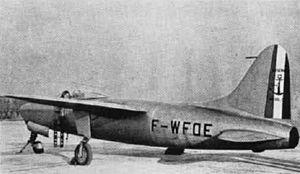| VG 90 | |
|---|---|
 | |
| Role | Prototype carrier-based fighter |
| Manufacturer | Arsenal de l'Aéronautique |
| First flight | 27 September 1949 |
| Status | Cancelled |
| Number built | 2 |
The Arsenal VG 90 was a French carrier-based jet-engined fighter developed in the late 1940s. It was intended to compete for an Aéronavale (French Naval Aviation) contract, but both of the completed prototypes were destroyed in fatal crashes and the program was cancelled in 1950 before the third prototype was completed.
Development and description
The single-seat VG 90 was intended to compete against the SNCAC NC 1080 and Nord N.2200 for an Aéronavale contract and was derived from Arsenal's earlier VG 70 and VG 80 research aircraft, with a high wing and all-swept flying surfaces. The intakes were mounted on the fuselage sides.
Flight testing
Both VG 90 prototypes were destroyed in fatal crashes early in the development programme. The first crash occurred on 25 May 1950, when an undercarriage door tore off in flight and struck the aircraft's tail. Pilot Pierre Decroo was killed in the crash. The second crash claimed the life of pilot Claude Dellys and took place on 21 February 1952 after the tail of the aircraft was torn off due to aerodynamic flutter. Dellys' ejection seat malfunctioned and did not fire. A third prototype, then under construction, was abandoned at this juncture.
Variants
VG 90
- Carrier-based fighter with a Rolls-Royce Nene turbojet, two completed.[1]
VG 91
- Production version of the VG 90 with a SNECMA Atar 101 turbojet, one built, but not completed.[2]
VG 92
- Land-based version of the VG 90 without folding wings and arrestor hook, project only.[2]
VG 93
VG 94
- VG 92 fitted with an afterburner, project only.[3]
Specifications
Data from X-Planes of Europe II: Military Prototype Aircraft from the Golden Age 1945–1974[4]
General characteristics
- Crew: 1
- Length: 13.44 m (44 ft 1 in)
- Wingspan: 12.6 m (41 ft 4 in)
- Wing area: 30.7 m2 (330 sq ft)
- Gross weight: 8,719 kg (19,222 lb)
- Fuel capacity: 2,800 litres (616 imp gal; 740 US gal)
- Powerplant: 1 × Hispano-Suiza-built Rolls-Royce Nene , 22.2 kN (5,000 lbf) thrust
Performance
- Maximum speed: 855 km/h (531 mph, 462 kn)
- Maximum speed: Mach 0.845
- Service ceiling: 12,000 m (39,000 ft)
- Rate of climb: 15.00 m/s (2,953 ft/min)
Armament
- 3 × 30 mm (1.2 in) autocannon (intended)
- 2 × 500 kg (1,100 lb) bombs
Citations
References
- Buttler, Tony (2015). X-Planes of Europe. II: Military Prototype Aircraft from the Golden Age 1946–1974. Manchester, UK: Hikoki Publications. ISBN 978-1-90210-948-0.
- Carbonel, Jean-Christophe (2016). French Secret Projects. 1: Post War Fighters. Manchester, UK: Crecy Publishing. ISBN 978-1-91080-900-6.
- Taylor, Michael J. H. (1989). Jane's Encyclopedia of Aviation. London: Studio Editions. p. 81.